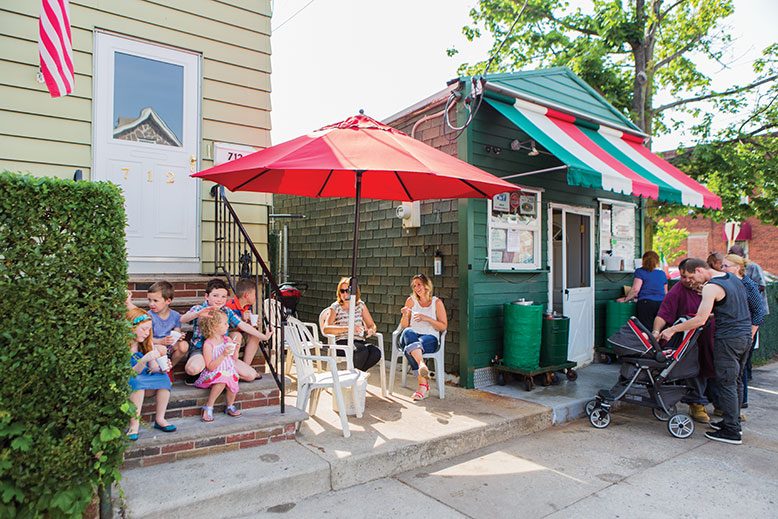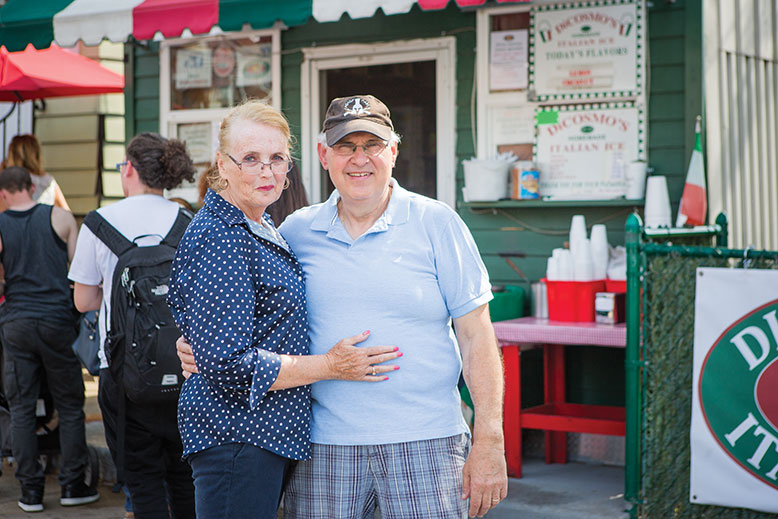
Italian ice is tricky stuff. It should be creamy, but without the taste of dairy. It should be icy, but without ice crystals.
“It should just dissolve, kind of linger on your tongue before it melts a little bit,” says Eileen O’Connor, who has been making the genuine article for 20 years. She enumerates still more qualities: “Not too whippy. Not too much air in it, and packed with flavor.”
O’Connor is part of the family that owns DiCosmo’s Italian Ice, a beloved institution in Elizabeth. Her great-grandparents, Italian immigrants Caterina and Giovanni DiCosmo, founded the business in 1915.
Mention DiCosmo’s Italian Ice and you’ll put a smile on the face of any Elizabethan. As the weather warms, police officers, municipal workers and families rub elbows in line outside the modest shop at 714 Fourth Avenue. Truckers detour off Routes 1 and 9 to get a taste. It’s that good. “People do go out of their way,” says O’Connor’s father, John DiCosmo, who has spent a lifetime in the business.
The workday at DiCosmo’s starts around 9:30 am, when John and his wife, Nancy, pick up fruit and juice from their Jersey suppliers. The shop usually offers four flavors each day. Lemon and coconut are always on the menu, but DiCosmo’s has a roster of 25 others to round out its lineup, including passion fruit, chocolate, pineapple, cherry and orange. As berries come into season, they are added to the mix.
Whatever the flavor, DiCosmo’s does things the old-fashioned way, never using juice from concentrate, artificial flavorings, preservatives, or corn syrup instead of sugar. John won’t disclose much about the family’s recipe, but here’s the gist: They make about 5 gallons per batch. After zesting, slicing or squeezing the fruit by hand, they churn the ingredients in a machine to a consistency “similar to mashed potatoes,” says O’Connor. Then they pack it into wooden barrels with a sleeve down the center stuffed with ice and rock salt. Rock salt is crucial to making Italian ice the old-fashioned way—it lowers the freezing point of the ice, assuring that the water in the mixture doesn’t freeze.
When Caterina and Giovanni founded DiCosmo’s 100 years ago, their neighborhood, known as Peterstown, was flush with Italian immigrants. DiCosmo’s served as a neighborhood grocery, selling items like milk and cigarettes. As a child in Italy, Caterina had enjoyed flavorful granitas—a semi-frozen dessert with a coarser texture than Italian ice. Missing those, she began making ices herself. DiCosmo’s was not the only Italian-ice game in town, but as families moved and stores closed, they became the place to go. The store evolved as well, phasing out grocery items and adding temptations such as penny candy.
Caterina and Giovanni’s son Alfred married in 1938. His bride, Agnes, learned the trade under Caterina’s tutelage. In those early years, the shop served only lemon. Agnes proposed new flavors. As Nancy relates, “She went to her mother-in-law and said, ‘Mom, I think we should try orange.’ Her mother-in-law said, ‘Who’s gonna eat orange? Only lemon. They only want lemon.’”
Agnes proved Caterina wrong, as orange exploded in popularity. Next Agnes introduced pineapple. (Lemon, orange and pineapple are “the trinity of flavors,” Nancy says.) Responding to customers’ enthusiasm, Agnes began experimenting with berries and peaches. “I remember sitting out back and cutting strawberries until our fingerstips were all red,” Nancy says.
The tropical flavors proved popular with the Hispanic newcomers who moved in as the Italians moved out. “They love it every bit, if not more so than the Italians did,” Nancy says.
Nancy, like Agnes, married into the DiCosmo clan. “My mother-in-law always said to me, ‘Nance, when I got married, I didn’t just marry my husband, I married the lemon-ice barrels,’” Nancy says. “Agnes didn’t have a high school education, but she was wise beyond her years. She really instilled in the kids that sense of pride in the product and their heritage.”
Nancy’s husband, John, has fond memories of growing up around the shop. As a boy, he sorted empty Coke and Pepsi bottles. As he grew, he learned to chop the 300-pound blocks of ice (delivered by George the Ice Man, “the strongest man I’ve ever known,” he says) into manageable chips.
Agnes and Alfred lived in the house next to the shop, where John and Nancy currently reside. Eileen remembers spending summers in the shop’s grassy backyard, sitting down every Sunday to a traditional Italian dinner with her five siblings, her grandmother hunched over a small outdoor stove, cooking up a feast.
Today, John and Nancy take pleasure in their 14 grandchildren. Their five daughters still live in New Jersey. Their son, John, ran the shop’s branch in Rockaway, Queens, until it was destroyed in Hurricane Sandy. The family aims to expand again. The younger John, who moved to California, hopes to open a shop on the West Coast.
The temperamental nature of the product—it’s not meant to be frozen and thawed—make expansion problematic. O’Connor says the family is researching licensing and distribution agreements. They would make the ices in concentrated form and sell them to a distributor. But the ices would still be made fresh daily in the company machines.
“This is something we enjoy making, we enjoy eating,” says O’Connor. “It’s part of us.”
While containing sugar, the DiCosmo product is relatively benign. It contains no additives or allergens. “I’ve had parents come up to me and say, ‘This is one of the few fun foods that my kid can have with their allergies,’” Eileen says with satisfaction.
DiCosmo’s is marking its centennial throughout the summer. The festivities will culminate on August 16 with balloon animals, cake, hourly drawings for prizes, and ices at the original price of 5 cents for a pleated paper cup. (Today a small styrofoam cup of DiCosmo ice costs $2.) The family will also collect donations for St. Jude’s Hospital and the Wounded Warrior Project.
While the city of Elizabeth has grown and changed in a century, the appeal of DiCosmo’s remains timeless.
“My mother-in-law had worried when the neighborhood started to change,” says Nancy. “She thought, Uh oh, is this going be the end?
“She worried needlessly. It’s wonderful.”





Who says you can`t go home again? This place takes me back to the early 1950`s when a cup was 25 cents and my friend Cathy worked there as a member of the family. Now she lives in Florida with huband nick who is also from Elizabeth. I did think the store went out of business.